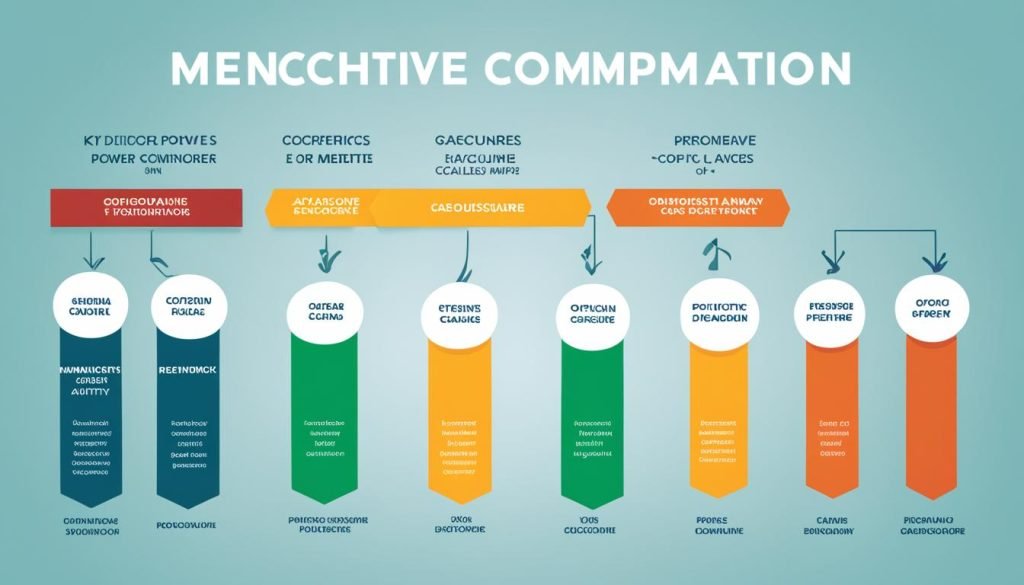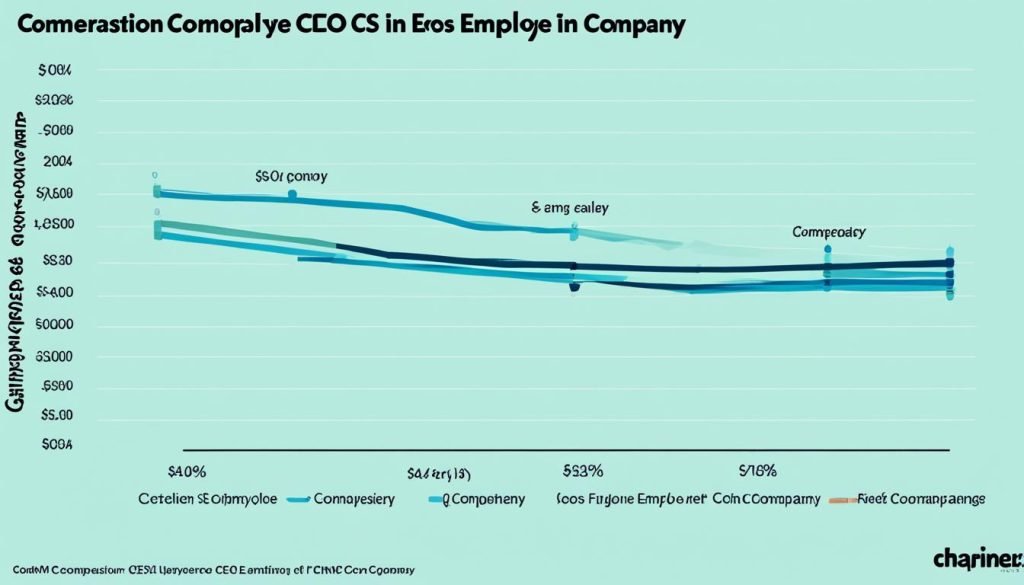When talking about how much top executives earn, being clear is crucial. The law says that public companies must share easily understood info about what they pay their top bosses. This includes the CEO, CFO, and other top leaders. You can find this info in different reports and statements they publish each year.
The Summary Compensation Table offers a peek into what a company’s chiefs earn. It shows the total amount of money including salaries, bonuses, and perks. This is important for anyone interested in knowing how companies reward their top leaders.
The part called Compensation Discussion and Analysis goes further. It explains why the company decides to give out certain pay packages. This gives a glimpse into whether the company is paying leaders in a way that’s good for the business and fair to everyone.
Understanding how companies pay their CEOs and other leaders is important. It helps us see if the pay is reasonable and makes sure it’s tied to how well the company does. This way, everyone, from investors to the public, knows what’s going on.
Key Takeaways:
- Executive compensation disclosures are required by federal securities laws for public companies.
- The Summary Compensation Table provides an overview of executive pay practices.
- The Compensation Discussion and Analysis section explains the relationship between executive compensation and corporate performance.
- Understanding executive compensation disclosures promotes transparency and accountability in corporate governance.
- Executive compensation plays a critical role in attracting and retaining top talent and driving organizational performance.
Key Elements of Executive Compensation Disclosures
There are key things we look at in executive compensation disclosures. They tell us a lot about how the top people in a company get paid. This info is on how much and what kind of pay CEOs, CFOs, and other top officers get.
These key elements include details like their salary, bonuses, stock options, and more. Everything from their pension plans to employment contracts is covered. Companies share this to be clear and honest about how they pay their top people.
These details also help us understand how companies decide on pay. This matters because it shows how well a company links top pay to success. This info is for people like shareholders and investors. It lets them see if the pay matches the company’s goals.
Companies must tell us about executive pay by law, in reports to the SEC. This includes the proxy statement, Form 10-K, and more. It’s key info for anyone who wants to know about a company’s executive pay.
Executive Compensation Disclosure Checklist:
- Salary
- Bonuses
- Stock options
- Long-term incentive plan awards
- Pension plans
- Employment contracts
Clear info on executive bonuses and big earning details helps everyone understand. This includes investors and the public. When companies share this info well, it makes things clearer. It helps people make better choices because they understand more.
“Executive compensation disclosures play a pivotal role in fostering transparency and accountability within organizations. The comprehensive reporting of compensation details empowers stakeholders to assess the alignment between executive pay and corporate performance.” – [Author Name]

| Category | Description |
|---|---|
| Salary | The fixed annual payment received by an executive |
| Bonuses | Additional compensation awarded based on performance |
| Stock Options | The right to purchase company stock at a predetermined price |
| Long-Term Incentive Plan Awards | Compensation tied to long-term company performance |
| Pension Plans | Retirement plans providing income after executive service |
| Employment Contracts | Terms of employment including compensation, benefits, and termination clauses |
New Regulations Affecting Executive Compensation Disclosures
The Securities and Exchange Commission (SEC) has set new rules. These rules change how companies share info on executive pay. The aim is to show clearly how executive pay links to the company’s success.
Now, companies have to tell us more about what their CEOs earn. This includes details on salaries, bonuses, and stocks. This helps everyone, from investors to the public, understand how CEO pay is set and its link to the company’s success.
There’s also a new rule that lets companies take back extra pay from executives. This can happen if the pay was based on wrong financial info or goals. It keeps companies honest about how they pay their leaders when they do well.
The job of making sure companies follow these rules falls on HR directors. They need to work with experts to figure out exactly what executives are paid. This includes understanding what fairness is when it comes to various kinds of compensation.
HR directors have to pick which financial goals are most important. These goals help decide how much executives get paid. HR directors need to make sure that the way they pay their top employees matches the company’s goals.
These rules push companies to be more open and honest about how they pay CEOs. By sharing more about CEO pay and having ways to take back extra money, companies want to show they’re playing fair. This makes everyone trust them more.
The Importance of Executive Compensation in Corporate Governance
Executive compensation is key in how businesses are run. It affects how well leaders perform, who they attract to work for them, taxes, what experts think, and how the public sees them. The pay for top leaders is structured to make sure their goals match the company’s. This way, everyone works together smoothly.
When companies are ready to start selling stocks to the public, they need to think hard about how they pay their top leaders. They must show they’re fair, clear, and follow good rules. Good pay practices make investors trust them more and bring in the best people.
These days, laws around the world say it’s very important for companies to be clear about how they pay their top leaders. They must share a lot of details about executive pay to help shareholders see what’s going on. These open talks about pay help make sure everyone’s on the same page and that leader’s pay is fair.
Also, people who might invest in the company and experts in the field check carefully on how executive pay matches the company’s success. This puts pressure on companies to get their leader’s pay right, follow all rules, and do their best in how they design pay packages.
Benefits of Transparent Executive Compensation:
- Enhances trust and credibility: Clear and open pay practices show the company is answerable and helps others trust it more.
- Attracts and retains top talent: An honest pay system brings in and keeps the best people who share the company’s big goals.
- Optimizes tax implications: Being clear on what leaders get paid helps companies handle taxes better and do well financially.
- Improves corporate governance: Sharing how leaders are paid helps keep a high level of corporate rules, which help the company grow for a long time.
Clear pay practices are good for how companies work together. They match leader’s goals to making the company succeed over time, benefiting everyone involved.
Putting a spotlight on how leaders are paid and making that information clear is vital for good management and constant growth. It helps build a firm grounding for doing well into the future.

Conclusion
Executive compensation disclosures are key for showing how businesses are run. Companies must follow certain laws and rules. This makes them share a lot about what they pay their top people. It’s all about being open, fair, and letting everyone know the true picture.
Good pay plans for leaders not only get and keep great talent. They also make sure that what the leaders work for, matches what the company wants to achieve. Everything about how they are paid is looked at carefully by investors and those who analyze companies. So, being clear is super important for how a company is seen.
We need to make sure top leaders’ pay is out in the open and done right. This builds trust and shows that a company wants to do the right thing. Making sure pay is fair, open, and links to how well they do, helps create a good company culture. This is important for doing well in a world where businesses are always competing.







